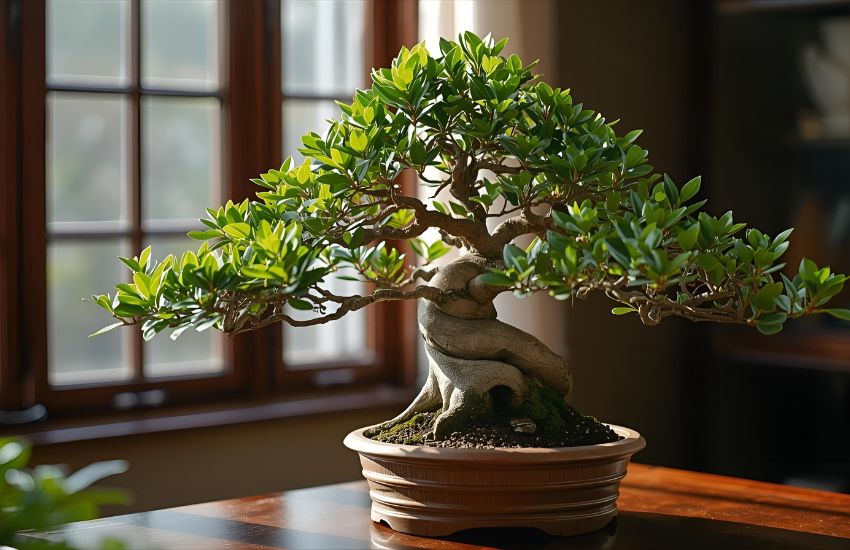The Ginseng Ficus Bonsai Tree offers more than just aesthetic appeal—it is a living piece of art that brings tranquility and elegance into your space. With its thick, bulbous trunk and glossy leaves, the Ficus microcarpa captivates both beginners and seasoned indoor bonsai enthusiasts. You can explore the unique style of this bonsai tree, shaping it carefully to reflect your personal taste while maintaining its natural charm.
Caring for a ginseng bonsai involves understanding essential techniques such as how to prune effectively, when to repot into the right pot, and how to propagate using cutting methods. These practices ensure your indoor bonsai remains healthy, vibrant, and a source of pride for years to come.
In this guide, you will discover practical tips on selecting the ideal pot, maintaining the ficus tree’s trunk and foliage, and mastering the art of pruning and styling your bonsai tree. By the end, you will feel confident in nurturing your own indoor bonsai, unlocking the timeless beauty and serenity that a Ginseng Ficus Bonsai Tree can bring into your home.
Ficus Bonsai Plant Care Guide: Prune, Repot, and Style Your Bonsai Tree

Caring for a Ficus Bonsai requires a balance of patience, attention, and knowledge of bonsai techniques. Whether you are nurturing a ficus ginseng, golden gate ficus, or ficus retusa, understanding the fundamentals of ficus bonsai care will help your bonsai plants thrive indoors or in controlled environments.
Pruning Your Ficus Bonsai
Pruning is essential to maintain the glossy leaves, healthy growth, and aesthetic shape of your bonsai. Use clean, sharp tools to snip unwanted branches and shape the canopy. For beginners and bonsai enthusiasts alike, pruning encourages new shoots and can help thicken the trunk over time. Pay attention to aerial roots—they can be styled creatively or trimmed carefully to maintain balance.
Repotting and Soil Tips
Repotting your bonsai into a high-quality bonsai pot with proper bonsai soil is crucial for healthy root development. Ensure your pot has drainage holes to prevent waterlogging. Repotting should generally occur every 2–3 years, during which you can graft or propagate new shoots to expand your bonsai’s style. Avoid disturbing the roots unnecessarily to prevent sap leakage or stress on the tree.
Styling and Shaping Techniques
The art of bonsai extends beyond pruning and repotting. You can style your ficus bonsai to mimic popular trees like willow or willow leaf forms, creating a graceful indoor display. Guide branches with wiring, manage aerial roots, and maintain the balance between trunk and foliage. Maintaining proper humidity and monitoring for pests or fungal issues ensures your bonsai remains vibrant and healthy.
By following these principles, you can nurture a popular tree like the fig tree or golden gate ficus with confidence, enjoying the timeless beauty and serenity that bonsai plants offer. With practice, your bonsai will reflect both your skill and your patience, making it a centerpiece of any indoor space.
Conclusion
Caring for your Ficus Bonsai is a rewarding journey that connects you to the natural habitat of this remarkable tree, native to Southeast Asia. By providing a proper soil mix or soil mixture, maintaining higher humidity or a humid environment, and using liquid fertilizer strategically, you can encourage green leaves, new growth, and a thriving waxy canopy reminiscent of its natural Moraceae family.
Regular pruning, such as prune back techniques and careful cut paste applications, helps maintain the bonsai’s shape, while repotting every other year ensures healthy root development. Attention to low humidity or high humidity conditions, along with vigilance against pests like spider mites, will keep your medium-sized ficus benjamina or other bonsai plants healthy.
For gardeners looking to mass-produce or style their bonsai, these steps preserve the beauty and longevity of your indoor bonsai, while honoring its tropical origins. Begin today to cultivate your own stunning Ficus Bonsai and experience the satisfaction of nurturing a living work of art that brings serenity and elegance to your space.
Frequently Asked Questions (Ficus Bonsai Plant: Discover the Timeless Beauty of Ginseng Ficus Bonsai Tree)
Is Ficus Ginseng a lucky plant?
Ficus Ginseng is considered a lucky plant in many cultures, especially in Feng Shui, where it symbolizes wealth, prosperity, and positive energy. Its unique, thick roots and lush foliage are believed to attract good fortune, harmony, and success when placed in homes or offices.
Is ficus bonsai indoor or outdoor?
Ficus bonsai is primarily an indoor plant, thriving in bright, indirect sunlight and stable temperatures. It can be kept outdoors in warm, humid conditions but should be protected from direct harsh sunlight and cold drafts. Regular watering and humidity help maintain its health indoors.
What is the significance of the Ficus Ginseng bonsai tree?
The Ficus Ginseng bonsai tree symbolizes good luck, prosperity, and harmony. Its thick, attractive roots and glossy leaves make it a popular decorative plant for homes and offices. Beyond aesthetics, it is believed to promote positive energy, reduce stress, and enhance overall well-being in indoor spaces.
Are ficus bonsai good for beginners?
Yes, Ficus bonsai are suitable for beginners because they are hardy, adaptable, and forgiving of minor care mistakes. They thrive indoors with moderate light, require regular watering, and respond well to pruning, making them an ideal choice for those new to bonsai cultivation and plant care.
